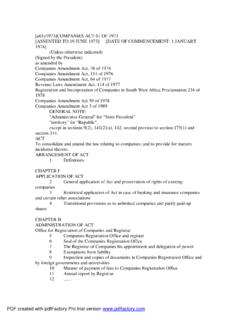Transcription of Mergers and acquisitions in the new era of …
1 Mergers and acquisitions in the new era of companies Act, 2013. February 2014. Foreword The new companies Act, 2013 has sought to streamline and make M&A more smooth and transparent. It appears that the New Act can help to deal with the challenges and complexities that the current procedures faces in relation to procedures that were contemplated under the old Act. The New Act has incorporated various provisions to tackles the problems actually faced during the process of Mergers , by taking into consideration the practical aspects of the process. The newly added provisions have made it easier for companies to implement Schemes of Arrangement'. ( Mergers & acquisitions , de-merger, corporate debt restructuring etc) and at the same time impose checks & balances to prevent abuse of these provisions. It is an attempt to fine tune the process by making it more efficient and in-tune effective.
2 The new law allows an Indian company to merge with a foreign company, making cross-border Mergers and acquisitions easier. The new law also disallows reverse merger of a listed company with that of an unlisted one. The New Act no doubt has some ambiguities attached to it, which would need to be sorted out in order to reduce any complexity in the process. It would need to reduce reliance on rules to be specified later and also ameliorate provisions that contrive other legislations. Against this backdrop, ASSOCHAM is actively involved in showcasing related programmes to bring updated knowledge and policy guidelines for the industry and all stakeholders. ASSOCHAM, jointly with Ernst & Young LLP is bringing out this compilation for the benefit of participants and practitioners. I wish all the best and success for the conference and assure that such knowledge based events shall continue to be held for the benefit of all segments of the industry and commerce.
3 Rawat Secretary General ASSOCHAM. Being the Chairman of M&A Council of the Associated Chambers of Commerce & Industry of India (ASSOCHAM), I am delighted to organize the National Conference on New Mergers & acquisitions Era under the companies Act, 2013 . There are pragmatic reforms for Merger and acquisitions under companies Act, 2013, which could make merger, acquisitions and restructuring easier for companies . Introduction of novel concepts fast track merger for Small companies and Holding and its wholly owned subsidiary companies , Cross Border merger (removing the restriction on only transferee company being Indian company). under this Act are expected to increase internal restructuring and Cross Border restructuring. Further exit opportunity to the dissenting shareholders is expected to reduce litigation & frivolous complaint and representation of Income Tax Department, Sectoral Regulators would safeguard their interest, though at the cost of prolonged process.
4 This is the first significant change to merger and amalgamations regime in the last six decades, with the previous companies Act having been in place since Ministry of Corporate Affairs has also prepare roadmap for companies Act, 2013 and in this direction in its recent circular given chance to Income Tax Department and other Sectoral Regulators to make their representation on Merger and Amalgamation in line with the provision of companies Act, 2013. I hope this National Conference gives rich insight and adequate knowledge to all the interested stakeholders. We shall be happy to receive comments /suggestions of the readers for making our future endeavors better. With warm wishes Pavan Kumar Vijay Chairman, M & A Council ASSOCHAM. Managing Director Corporate Professionals Corporate law has undergone a radical change with the introduction of the companies ' Act, 2013.
5 In India during this era of major economic overturns. Pursuant to receiving the final nod from the President in August 2013, the enactment of the companies ' Act, 2013 has been a significant step in the path of adapting with laws suitable for our times. The provisions enacted in the new legislation bring India at par with its global peers from a corporate law perspective on several fronts. A bright spot in the history of India's legislative initiatives, the new Act aims to improve transparency and accountability in India's corporate sector. It retains the fundamental provisions of the earlier Act while incorporating stronger and progressive new provisions. In the recent past, India's economy has outperformed the West on its growth and attracted large inflows of foreign funds. Economists predict that the West will soon begin heading northwards.
6 In this environment, Indian investors will get significant exposure to global economies. Furthermore, with opening up of international opportunities, companies can look at scenarios where strategic alliances take simpler routes, and global consolidation and fund-raising are required. Global integration and cross-border Mergers are now permitted, which is an excellent change from the earlier environment in which only foreign companies were welcomed in India. The challenges faced by many corporate organizations in listing their businesses abroad if their entire business value is housed in India will now be reduced due to cross-border Mergers , which will enable them to set up overseas listing vehicles. The introduction of Class Action Suits, the concept of arms' length pricing in related party transactions, the focus on Corporate Social Responsibility, recognition of inter-se shareholder rights, opening of doors to outbound Mergers , fast-track Mergers , an increased focus on governance and protection of minority shareholders are important initiatives for organizations to move toward global best practices.
7 This paper elaborates on the key provisions of the corporate law affecting Mergers and acquisitions . The new Act prescribes rules for implementation of its provisions. However, the Rules are at the draft stage at present. It is hoped their implementation will help Indian corporate laws achieve parity with international ones and smoothen the transition from the companies Act, 1956 to the companies Act, 2013. It will also help organizations gauge whether Indian corporate laws are focusing northwards. I wish to acknowledge the contribution made by my EY tax colleagues and their untiring efforts in preparing an extensive in-depth comprehensive study on this subject. We hope this booklet will provide relevant insights and adequate knowledge to all stakeholders in the M&A arena and we wish the conference great success. Amrish Shah Partner and Transaction Tax Leader EY Table of contents companies Act 2013: M&A landscape 2.
8 companies Act 2013: impact on transactions 18 12 6. companies Act 2013: Mergers , compromises and arrangements companies Act 2013: capital structuring and other M&A related aspects Chapter 1. companies Act 2013: M&A landscape 2 Mergers and acquisitions in the new era of companies Act, 2013. The companies Act, 1956 had almost reached its retirement mandates in the case of Mergers of small enterprises, holding age after having been in existence for more than five-and-a- companies and their wholly owned subsidiaries, etc., where the half decades. It was essential that robust and young corporate approval of NCLT will not be required. This liberalization will ease laws were introduced in the system. This journey began in the burden of regulatory authorities and do away with lengthy 2008, when the companies Bill, 2008 was first introduced in implementation timelines, especially in these times when a the Lok Sabha.
9 However, it hit a road-block on its introduction strengthened focus on business is the key. in August 2008 and had to be withdrawn due to dissolution The minimum thresholds of 10% and 5% for shareholders and of the Lok Sabha. The Bill was re-introduced in Parliament creditors objections, respectively, are expected to eliminate the in 2009 and was subsequently sent to the Standing Finance frivolous objections of small shareholders who oppose deals Committee. After considerable deliberation with stakeholders, under the guise of shareholder activism. Meetings of creditors the Committee presented its report to the Lok Sabha in may be dispensed with if 90% of creditors (in value) give their August 2010. Taking into consideration the recommendations consent to this. This amendment is welcome in view of courts of the report, a revised version of the Bill was again referred to being inconsistent on the matter of dispensation of meetings for the Committee in 2011 with the inclusion of certain creditors.
10 However, the need for affidavits may become onerous. new provisions. While SEBI has introduced provisions to regulate the accounting The Bill was passed by both the houses of Parliament between treatment for listed companies , the new Act also brings the December 2012 and August 2013. The President signed on accounting treatment of unlisted ones under the radar of the the dotted line on 29 August 2013, providing his much awaited regulatory authorities. The NCLT cannot sanction a scheme consent to the 29 chapters, 470 clauses and 7 schedules unless a certificate from the auditor is submitted, stating comprising the companies ' Act, 2013. This marked a landmark that the accounting treatment is correct. In this scenario, event in the history of Indian corporate law. there ought to be reduced accounting flexibility in the case of The Ministry of Corporate Affairs has opted for phased unlisted companies , pursuant to a scheme of arrangement.

















